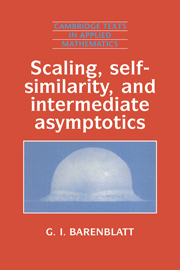 Scaling, Self-similarity, and Intermediate Asymptotics
Scaling, Self-similarity, and Intermediate Asymptotics Book contents
- Frontmatter
- Dedication
- Contents
- Preface
- Foreword
- Introduction
- 1 Dimensions, dimensional analysis and similarity
- 2 The construction of intermediate-asymptotic solutions using dimensional analysis. Self-similar solutions
- 3 Self-similarities of the second kind: first examples
- 4 Self-similarities of the second kind: further examples
- 5 Classification of similarity rules and self-similar solutions. A recipe for the application of similarity analysis
- 6 Scaling and transformation groups. Renormalization group
- 7 Self-similar solutions and travelling waves
- 8 Invariant solutions: asymptotic conservation laws, spectrum of eigenvalues, and stability
- 9 Scaling in the deformation and fracture of solids
- 10 Scaling in turbulence
- 11 Scaling in geophysical fluid dynamics
- 12 Scaling: miscellaneous special problems
- Afterword
- References
- Index
Introduction
Published online by Cambridge University Press: 18 December 2014
- Frontmatter
- Dedication
- Contents
- Preface
- Foreword
- Introduction
- 1 Dimensions, dimensional analysis and similarity
- 2 The construction of intermediate-asymptotic solutions using dimensional analysis. Self-similar solutions
- 3 Self-similarities of the second kind: first examples
- 4 Self-similarities of the second kind: further examples
- 5 Classification of similarity rules and self-similar solutions. A recipe for the application of similarity analysis
- 6 Scaling and transformation groups. Renormalization group
- 7 Self-similar solutions and travelling waves
- 8 Invariant solutions: asymptotic conservation laws, spectrum of eigenvalues, and stability
- 9 Scaling in the deformation and fracture of solids
- 10 Scaling in turbulence
- 11 Scaling in geophysical fluid dynamics
- 12 Scaling: miscellaneous special problems
- Afterword
- References
- Index
Summary
Dimensional analysis and physical similarity
The starting point of this book is dimensional analysis and it is used throughout. Like unhappy families, every unfortunate scientific idea is unfortunate in its own way. Many of those who have taught dimensional analysis (or have merely thought about how it should be taught) have realized that it has suffered an unfortunate fate.
In fact, the idea on which dimensional analysis is based is very simple, and can be understood by everybody: physical laws do not depend on arbitrarly chosen basic units of measurement. An important conclusion can be drawn from this simple idea, using a simple argument: the functions that express physical laws must possess a certain fundamental property, which in mathematics is called generalized homogeneity or symmetry. This property allows the number of arguments in these functions to be reduced, thereby making it simpler to obtain them (by calculating them or determining them experimentally). This is, in fact, the entire content of dimensional analysis – there is nothing more to it.
Nevertheless, using dimensional analysis, researchers have been able to obtain remarkably deep results that have sometimes changed entire branches of science. The mathematical techniques required to derive these results turn out to be simple and accessible to all. The list of great names involved runs from Newton and Fourier to Maxwell, Rayleigh and Kolmogorov. Among recent developments, it is sufficient to recall the triumph of the Kolmogorov–Obukhov theory in turbulence.
Everyone would like to score a classical triumph. Many people therefore attacked what one would think were almost identical problems using the same simple dimensional analysis approach. Alas, they almost always failed. Dimensional analysis was cursed and reproached for being untrustworthy and unfounded, even mystical. Paradoxically, the reason for this lack of success was that only a few people understood the content and real abilities of dimensional analysis.
- Type
- Chapter
- Information
- Scaling, Self-similarity, and Intermediate AsymptoticsDimensional Analysis and Intermediate Asymptotics, pp. 1 - 27Publisher: Cambridge University PressPrint publication year: 1996
